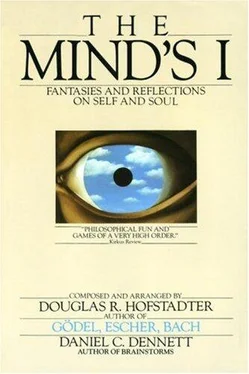D.R.H.
D.C.D.
5
Douglas R. Hofstadter
The Turing test: A Coffeehouse Conversation [7] This selection appeared previously as “Metamagical Themas: A Coffeehouse conversation on the Turing test to determine if a machine can think.” In Scientific American, May 1981, pp. 15–36.
PARTICIPANTS
Chris, a physics student, Pat, a biology student, and Sandy, a philosophy student.
CHRIS: Sandy, I want to thank you for suggesting that I read Alan Turing’s article “Computing Machinery and Intelligence.” It’s a wonderful piece and it certainly made me think—and think about my thinking.
SANDY: Glad to hear it. Are you still as much of a skeptic about artificial intelligence as you used to be?
CHRIS: You’ve got me wrong. I’m not against artificial intelligence. I think it’s wonderful stuff—perhaps a little crazy, but why not? I simply am convinced that you AI advocates have far underestimated the human mind and that there are things a computer will never, ever be able to do. For instance, can you imagine a computer writing a Proust novel? The richness of imagination and complexity of the characters....
SANDY: Rome wasn’t built in a day.
CHRIS: In the article Turing comes through as an interesting person. Is he still alive?
SANDY: No, he died back in 1954, at just forty-one. He’d only be sixty-seven this year, although he is now such a legendary figure it seems strange to imagine him still alive today.
CHRIS: How did he die?
SANDY: Almost certainly suicide. He was homosexual and had to deal with a lot of harsh treatment and stupidity from the outside world. In the end it apparently got to be too much and he killed himself.
CHRIS: That’s a sad story.
SANDY: Yes, it certainly is. What saddens me is that he never got to see the amazing progress in computing machinery and theory that has taken place.
PAT: Hey, are you going to clue me in as to what this Turing article is about?
SANDY: It is really about two things. One is the question “Can a machine think?”—or rather “Will a machine ever think?” The way Turing answers this question—he thinks the answer is “yes,” by the way—is by batting down a series of objections to the idea, one after another. The other point he tries to make is that the question is not meaningful as it stands. It’s too full of emotional connotations. Many people are upset by the suggestion that people are machines, or that machines might think. Turing tries to defuse the question by casting it in a less emotional terms. For instance, what do you think, Pat, of the idea of “thinking machines?”
PAT: Frankly, I find the term confusing. You know what confuses me? Its those ads in the newspapers and on TV that talk about “products that think” or “intelligent ovens” or whatever. I just don’t know how seriously to take them.
SANDY: I know the kind of ads you mean, and I think they confuse a lot of people. On the one hand we’re given the refrain “Computers are really dumb, you have to spell everything out for them in complete detail,” and on the other hand we’re bombarded with advertising hype about “smart products.”
CHRIS: That’s certainly true. Did you know that one computer terminal manufacturer has even taken to calling its products “dumb terminals” in order to make them stand out from the crowd?
SANDY: That’s cute, but it just plays along with the trend toward obfuscation. The term “electronic brain” always comes to my mind when I’m thinking about this. Many people swallow it completely, while others reject it out of hand. Few have the patience to sort out the issues and decide how much of it makes sense.
PAT: Does Turing suggest some way of resolving it, some sort of IQ test for machines?
SANDY: That would be interesting, but no machine could yet come close to taking an IQ test. Instead, Turing proposes a test that theoretically could be applied to any machine to determine whether it can think or not.
PAT: Does the test give a clear-cut yes or no answer? I’d be skeptical if it claimed so.
SANDY: No, it doesn’t. In a way, that’s one of its advantages. It shows how the borderline is quite fuzzy and how subtle the whole question is.
PAT: So, as is usual in philosophy, it’s all just a question of words.
SANDY: Maybe, but they’re emotionally charged words, and so it’s important, it seems to me, to explore the issues and try to map out the meanings of the crucial words. The issues are fundamental to our concept of ourselves, so we shouldn’t just sweep them under the rug.
PAT: So tell me how Turing’s test works.
SANDY: The idea is based on what he calls the Imitation Game. In this game a man and a woman go into separate rooms and can be interrogated by a third party, via some sort of teletype setup. The third party can address questions to either room, but he has no idea which person is in which room. For the interrogator the idea is to discern which room the woman Is in. Now the woman, by her answers, tries to aid the interrogator as much as possible. The man, however, is dong his best to bamboozle the interrogator by responding as he thinks a woman might. And if he succeeds in fooling the interrogator…
PAT: The interrogator only gets to see written words, eh? And the sex of the author is supposed to shine through? That game sounds like a good challenge. I would very much like to participate in it some day. Would the interrogator know either the man or the woman before the test began? Would any of them know the others?
SANDY: That would probably be a bad idea. All sorts of sublimal cueing might occur if the interrogator knew one or both of them. It would be safest if all three people were totally unknown to each other.
PAT: Could you ask any questions at all, with no holds barred?
SANDY: Absolutely. That’s the whole idea.
PAT: Don’t you think then, that pretty quickly it would degenerate into very sex-oriented questions? I can imagine the man, overeager to act convincing, giving the game away by answering some very blunt questions that most women would find too personal to answer, even through an anonymous computer connection.
SANDY: It sounds plausible.
CHRIS: Another possibility would be to probe for knowledge of minute aspects of traditional sex-role differences, by asking about such things as dress seizes and so on. The psychology of the Imitation Game could get pretty subtle. I suppose it would make a difference if the interrogator were a woman or a man. Don’t you think that a woman could spot some telltale differences more quickly than a man could?
PAT: If so, maybe that’s how to tell a man from a woman!
SANDY: Hmm… that’s a new twist! In any case, I don’t know if this original version of the Imitation Game has ever been seriously tried out, despite the fact that it would be relatively easy to do with modern computer terminals. I have to admit, though, that I’m not sure what it would prove, whichever way it turned out.
PAT: I was wondering that. What would it prove if the interrogator—say, a woman—couldn’t tell correctly which person was the woman? It certainly wouldn’t prove that the man was a woman.
SANDY: Exactly! What I find funny is that although I fundamentally believe in the Turing test, I’m not sure what the point is of the Imitation Game, on which it’s founded.
CHRIS: I’m not any happier with the Turing test for “thinking machines” than I am with the Imitation Game as a test for femininity.
PAT: From your statements I gather that the Turing test is a kind of extension of the Imitation game, only involving a machine and a person in separate rooms.
SANDY: That’s the idea. The machine tries its hardest to convince the interrogator that it is the human being, while the human tries to make it clear that he or she is not a computer.
Читать дальше











